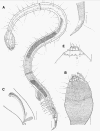
| Male of Megadraconema
cornutum Rho et al., 2011 A=entire body; B=surface anterior; C=spicules; D=detail of head capsule |
Revised 03/17/25
Chromadoria
Desmodoroidea
Draconematidae Filipjev, 1918
Type genus of the family: Draconema Cobb, 1913
A family of free-living marine nematodes
Characterized by the presence
of specialized locomotory structures, such as cephalic adhesion tubes in the
head region and sublateral
and subventral posterior adhesion tubes in the
posterior body region (Allen and Noffsinger, 1978;
They inhabit various marine habitats throughout the world, including shallow intertidal sandy beaches, deep-sea hydrothermal vents, the surface of sea grasses, and in coralline habitats.
Decraemer et al. (1997) revised the family Draconematidae into two subfamilies: the Draconematinae Filipjev, 1918 and the Prochaetosomatinae Allen & Noffsinger, 1978.
Body short, S-shaped, usually with more or less enlarged pharyngeal and mid-body region.
Cuticle annulated except for head capsule and tail terminus, Annules sometimes with spines, minute vacuoles, or a longitudinal lateral field in mid-body region or tail region.
Cephalic sensillae in three circles: six inner labial papillae, six outer labial setae, and four cephalic setae.
Rostrum present except in Dinetia Decraemer & Gourbault, 1997.
Amphideal fovea spiral to loop-shaped, rarely reduced or an internal longitudinal bar.
Cephalic adhesion tubes present, located dorsally on cephalic capsule.
Somatic setae arranged in eight longitudinal rows.
Buccal cavity small to well developed, usually with a dorsal tooth, with or without subventral teeth.
Pharynx cylindrical, dumbbell-shaped, or with posterior bulb. Secretory–excretory system absent.
At least the anterior-most posterior adhesion tubes arranged in four longitudinal rows, two subventrally and two ventrosublaterally, located on posterior third of body. Posterior adhesion tubes with or without differentiated tip, usually straight, rarely long and flexible.
Male copulatory apparatus with two spicules and trough-shaped gubernaculum.
Three caudal glands extending beyond anus or cloaca.
Ref: Rho et al., 2011; Leduc and Zhao, 2016

Male of Megadraconema
cornutum Rho et al., 2011
A=entire body; B=surface anterior;
C=spicules; D=detail of head capsule
Allen MW, Noffsinger EM (1978) A revision of the marine nematodes of the superfamily Draconematoidea Filipjev, 1918 (Nematoda: Draconematina). Univ Calif Publs Zool 109: 1–133
Decraemer W, Gourbault N, Backeljau T (1997) Marine nematodes of the family Draconematidae (Nemata): a synopsis with phylogenetic relationships. Hydrobiologia 357: 185–202.
Leduc, D., Zhao, Z. 2016. Phylogenetic relationships within the superfamily Desmodoroidea (Nematoda: Desmodorida), with descriptions of two new and one known species. Zoological Journal of the Linnean Society, 176: 511–536. https://doi.org/10.1111/zoj.12324
Rho, H.S., W. Decraemer, M.V. Sørensen, W.G. Min, J. Jung and W. Kim. 2011. Megadraconema cornutum, a New Genus and Species from Korea, with a Discussion of Its Classification and Relationships within the Family Draconematidae (Nematoda, Desmodorida) Based on Morphological and Molecular Characters. Zoological Science, 28:68-84.